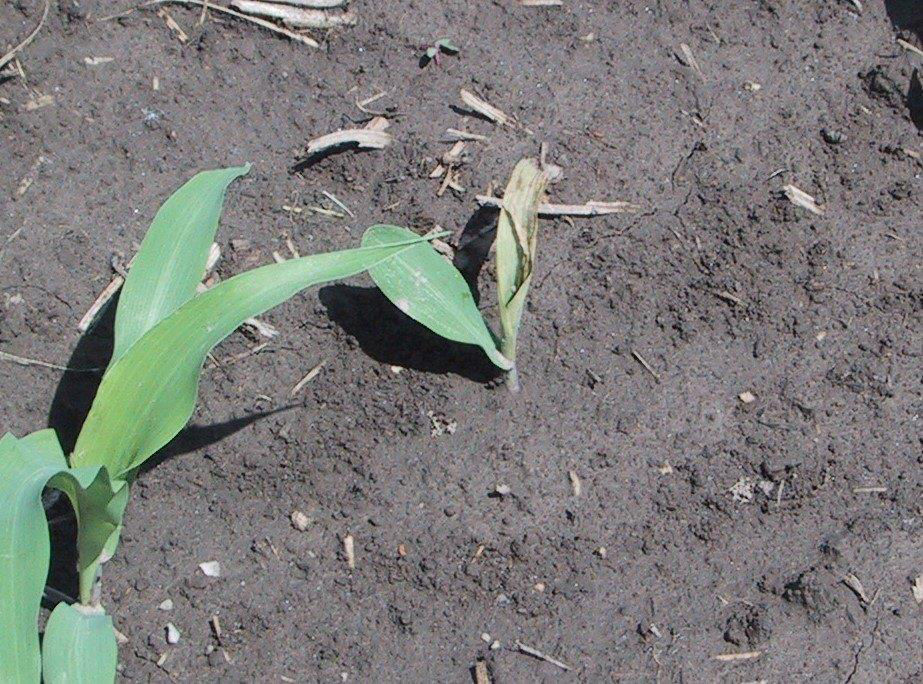Wireworm Management in Corn
April 18, 2024
Several wireworm species can injure corn. The primary group are species in the genus Melanotus; however, there are other species including those in the genera Aeolus, Conoderus, Hemicrepidius, and Limonius (Figure 1). The corn wireworm, Melanotus communis Gyllenhal, is the most common wireworm attacking corn in the northern central states of the US and constitutes up to 85% of the total click beetle population present in the region.1 The corn wireworm is also the most abundant species in southeastern states.1 Wireworms are the larval stage of click beetles, so named because of the clicking sound they make while attempting to right themselves after being placed on their backs. Wireworms of most species have a slender elongated body and are dark brownish orange. They have a distinct head capsule and projecting mouthparts. True legs are small but present near the head.

What are the host plants of wireworms?
In addition to corn, wireworms attack wheat, potato, soybean, and several other agronomic and vegetable crops. The species that attack corn are associated with grass and fields that were formerly in sod and are at higher risk for damage.
What is the life cycle of wireworms?
Wireworms overwinter as larvae in the soil. Depending on species and soil temperature, most wireworms move up and down within the soil profile and are near the surface in the spring and deeper later in the season. Although Conoderus spp. completes its life cycle in a single season, most species can have multi-year life cycles, up to five years, depending on food supply and local soil temperatures. Adults emerge in the summer and are often attracted to outside lights.
How do wireworms injure corn?
Wireworms can injure corn in two ways, one by feeding on seed and consuming the germ resulting in a failure to emerge and by tunneling into the plant belowground causing what is referred to as “dead heart” (Figure 2). On seedling corn, the growing point appears to be preferred. If the growing point is damaged, the aboveground symptoms include wilting or stunting. Stunted plants are often purple or dark in color. Closer inspection reveals holes or tunnels in seed, roots, and lower stems. If the plant survives, an ear is not produced.
Damage is often worse in cooler springs when corn development is slowed. Yield loss can occur because of reduced stand and stunted uncompetitive plants. Historically, wireworm problems have been associated with fields planted after sod. However, considerable injury has occurred to fields in a corn-soybean rotation associated with previous year’s grassy weeds.

What is the scouting technique for wireworms?
Bait stations placed randomly in about ten field locations can be used to help determine if a field is infested with wireworms prior to planting. The stations consist of about one cup of pre-moistened grain (corn, wheat, oats), buried about 4-inches deep, covered first with soil, and then black plastic to warm the grain. After a week, uncover the bait station and observe for and count any wireworms. Thresholds are subjective; however, if more than one wireworm is present, there is a potential for crop injury.2
Scouting after emergence through V5 growth stage should be done to observe for potential injury, particularly in the most vulnerable fields. If an infestation is observed, management strategies for the next growing season should be considered because wireworm life cycles are lengthy. Scouting should be combined with evaluation of corn emergence, weeds, and other early season corn insect pests such as cutworms, white grubs, and seed corn maggot.
How can wireworms be managed?
There are no rescue treatment options for corn wireworms. Preventable strategy is recommended for fields at risk by using a labeled at-plant rootworm soil insecticide or neonicotinoid insecticide treated corn seed. Fields at risk include CRP, pasture, or alfalfa and in replant situations. In-furrow placement of liquid and granular insecticides provide more consistent control.3
Are there other pests that can be confused with wireworms?
Occasionally, there are two other pests that can be confused with wireworms. False wireworms are the larvae of darkling beetles, of which there are several species. They occur in the western part of the US and Canada and are most commonly a pest of wheat. The other one is not an insect but a millipede (Figure 3). Millipedes feed on decaying organic matter and occasionally corn seeds if they are exposed or on corn seedlings as they emerge. They range in body size (1/4 to 1 1/4 inches long) and are dark in color. They have a round body, a pair of antennae, reduced chewing mouthparts that scrape food, and most segments have two pairs of legs.

Sources
1Gill, H.K., Chahil, G., Goyal, G., Gillett-Kaufman, J.L., and Cherry, R. 2020. Corn wireworm. Featured Creatures. Entomology & Nematology. University of Florida. https://entnemdept.ufl.edu/creatures/field/corn/corn_wireworm.htm
2Koch, R. and Wold-Burkness, S. 2015. Wireworm on soybean. University of Minnesota Extension. https://extension.umn.edu/soybean-pest-management/wireworm-soybean
3Potter, B. 2018. Wireworms and corn. University of Minnesota Extension. https://extension.umn.edu/corn-pest-management/wireworms-and-corn#at-risk-fields-1190860
Web sources verified 3/21/24. 1215_382301